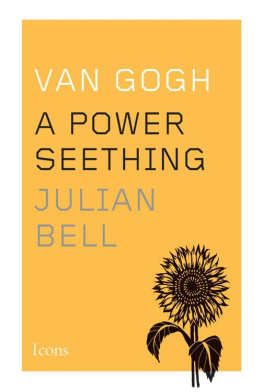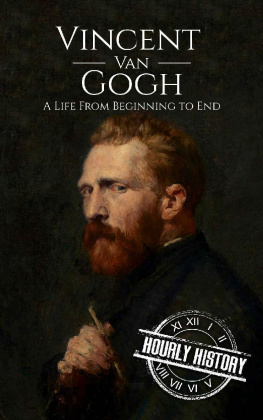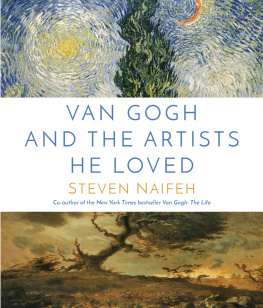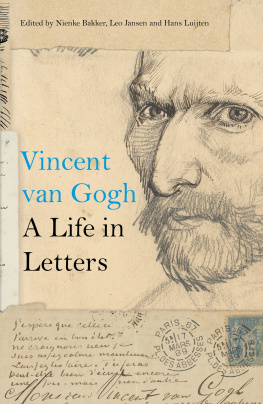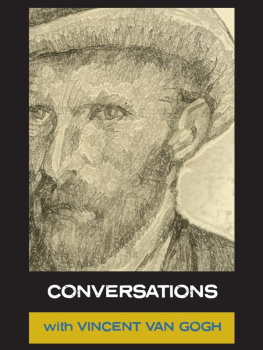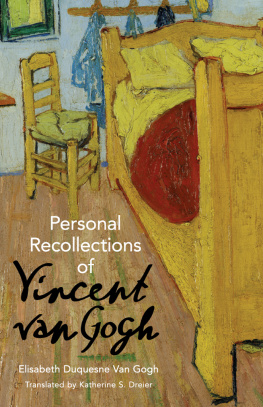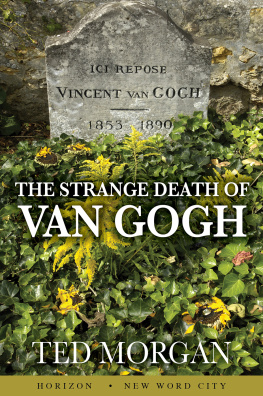Advanced Praise for
Van Gogh"Vincent Van Goghs life story is almost too well known, but Julian Bell has made it harrowing, urgent, and touching all over again. Bell's pulsing, immaculately carpentered language is an event in itself. Passage after passage made me stare in wonder (and some jealousy) at his word choices and the never conventional rhythms of his sentences. And how great to have Van Goghs story told without heroics or sentimentalityand with the edgy vitality with which it was lived."
Sanford Schwartz
What distinguishes Bell's elegant rendering is an astute perception of his artistic vision and shimmering descriptions of his workA graceful, empathetic, deeply probing portrait.
Kirkus Reviews
Bell bring his insight as a fellow artist to the life and work of Vincent Van Gogh in a condensed, accessible primer on the renowned artist."
Publishers Weekly
In this astutely and poetically distilled biography, Bell draws us into Van Goghs life and consciousness as he chronicles the artists struggles with familial and societal expectations and offers fresh and intimate insightsA vividly illuminating portrait both for readers versed in Van Gogh and those who are newly curious.
Booklist

ALSO BY JULIAN BELL
Bonnard
What Is Painting? Representation and Modern Art
Mirror of the World: A New History of Art

Text copyright 2015 by Julian Bell
All rights reserved.
No part of this work may be reproduced, or stored in a retrieval system, or transmitted in any form or by any means, electronic, mechanical, photocopying, recording, or otherwise, without written permission of the publisher.
Published by Amazon Publishing, New York
www.apub.com
Amazon, the Amazon logo and Amazon Publishing are trademarks of Amazon.com, Inc. or its affiliates.
eISBN: 9781477851296
Author photograph Elizabeth Roberts
Cover design by Rodrigo Corral Design
This book is dedicated to the memory of Oliver Lindsay Scott, 19512011
Contents
Introduction
I HAVE WRITTEN THIS book out of my love for Vincent van Gogh, the uniquely exciting painter, and Vincent van Gogh, the letter writer of heart-piercing eloquence. Researching it, I have gotten to know something of Vincent the social animal, the misfit tearing a ragged course through the late nineteenth-century Netherlands and France. I have also come to love this third side of Vincent, although I do not always like him. I have written the book because, as I see it, there is an open space among the three facets of the man. Although the letters offer the greatest commentary any artist has ever supplied on his own work, they may often be at odds with what Vincent actually painted and with the record of his actions, and indeed they are frequently at odds with one another. These internal differences ask for some outside voice to interpret them. My objective has been to offer an interpretation that is up to date, unmystified, concise and at the same time compassionate.
Concision is the objective because at the point at which I write, in 2013, the resources for biography have become so huge. When it comes to the more than twenty-one hundred paintings, drawings and prints that Vincent produced during his ten-year career as an artist, the one-volume catalogue raisonn by Jan Hulsker (last revised in 1996) is now being supplemented by a series of catalogues detailing the collection of Amsterdams recently refurbished Van Gogh Museum. The volumes that have been published to date are models of contemporary scholarship. The same is true of the marvellously produced complete edition of the letters, published in 2009 and edited by Leo Jansen, Hans Luitjen and Nienke Bakker. When it comes to the factual record of actions, anyone such as myself who is interested in Vincent can only be deeply grateful to Steven Naifeh and Gregory White Smith for the thoroughness with which they have compiled and interrogated the evidence in their 953-page Van Gogh: The Life (2011), however one may judge their deductions.
I come to this task with my own experience of working as a painter. From that angle, Vincents actions seem to matter because his paintings matter, rather than vice versa. I believe he would have agreed with that order of priorities, and I also believe that much of his life was spent joyfully because it was spent in this kind of work. Nonetheless, my sense of the occasion, as I put forward this account of Vincent, has less to do with painting than with performance. With such an orchestra of information as is now at hand, with such a complex score, a newcomer can only mount the stage in trepidation. Here follows an attempt to find the melody and pitch.

1
Saint
A S A BOY, Vincent van Gogh liked exploring scrub and stream banks. His eyes would be drawn to a wrens nest hidden in a heathland bramble patch, with its cone of stalks and leaves and moss, or to those of sparrows and thrushes in the hawthorns, or the woven hammocks of the golden oriole. (Count the wren and the oriole among the artists, he would later write.) Nearer home, he would crouch at a creek, reaching between cress and rushes to snatch up diving beetles and slip them in a bottle.
The province of Brabant, straddling the Netherlands border with Belgium, is largely poor, sandy land, and as of the 1860s, the acreage won from its heaths and oak- and pinewoods was still quite slight. These rye fields stretched beside one bank of the stream, homes to larks that rose from them in summer. On the other, meadows and potato plots bordered the path sloping up towards the garden gate. Elisabeth Lies van Gogh, six years Vincents junior, remembered the figure her brother cut as he approached that gate: stocky, forceful, with his shoulders hunched and his brow furrowed over small and deep-set eyes.the bottle. He added the expeditions insect haul to a collection in a lined cardboard box, neatly inscribing Latin names above each pinned specimen.
Vincents mother also Anna, ne Carbentus was in the garden to tend its beds of marigolds and moss roses, to instruct the gardener as to the pea rows and fruit trees beyond and to encourage her children to work the plots shed assigned them. Her husband, Dorus (short for Theodorus), liked to sit there to write his sermons. Sunday mornings, Dorus stepped out the front door his family behind him, likewise dressed in black and headed right along the south side of the marketplace of Zundert, crossing another sandy village square, to take up his duties as rector to the Dutch Reformed Church. Little admired in the pulpit a short, slight man who mumbled and rambled he nonetheless maintained moral, educational and financial authority among his small congregation, standing up for Protestant interests in a predominantly Catholic corner of the Netherlands.
While most of Zunderts peasantry shared a faith with their fellow Brabanters across the adjacent Belgian border, the Van Goghs upheld urban Dutch culture in the straggling heath-side settlement. Improving reading matter filled the parsonage. The Bible held supremacy, but so much in modern writing seemed to complement it. Charles Dickenss A Christmas Carol urged those huddled together at the fireside to feel how desolate life could become without mutual compassion. Johann David Wyss told the tale of
Next page
